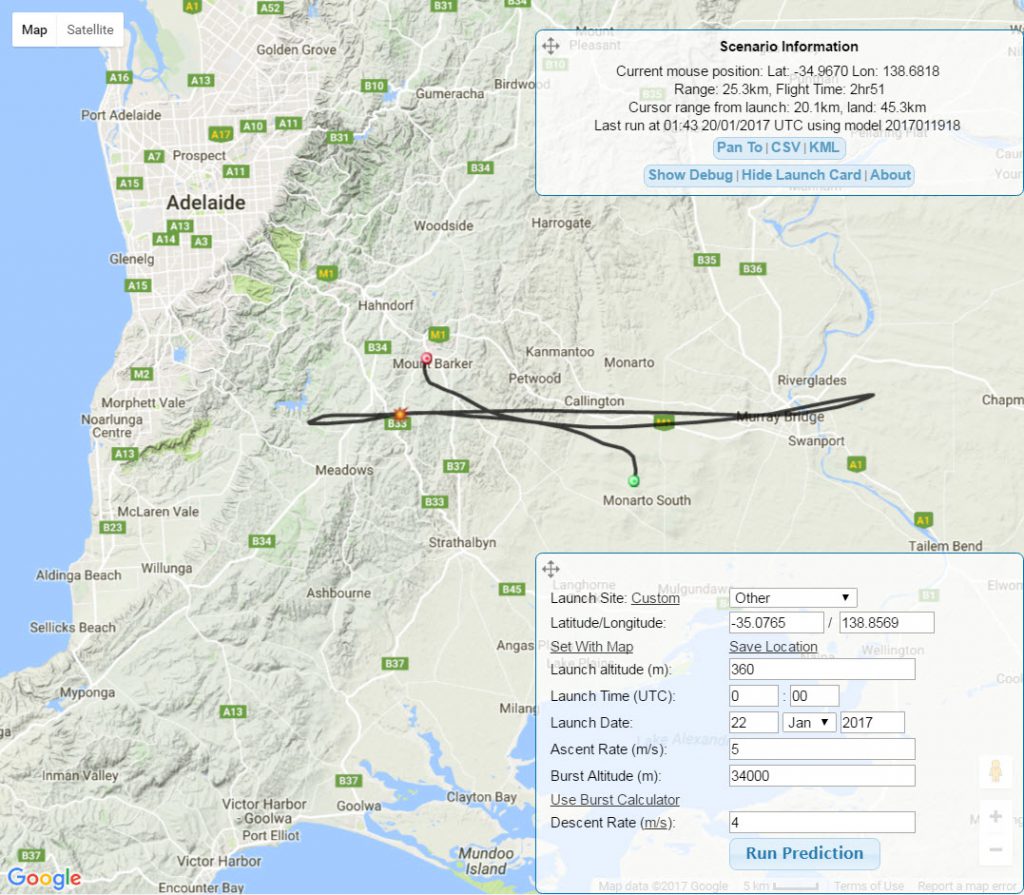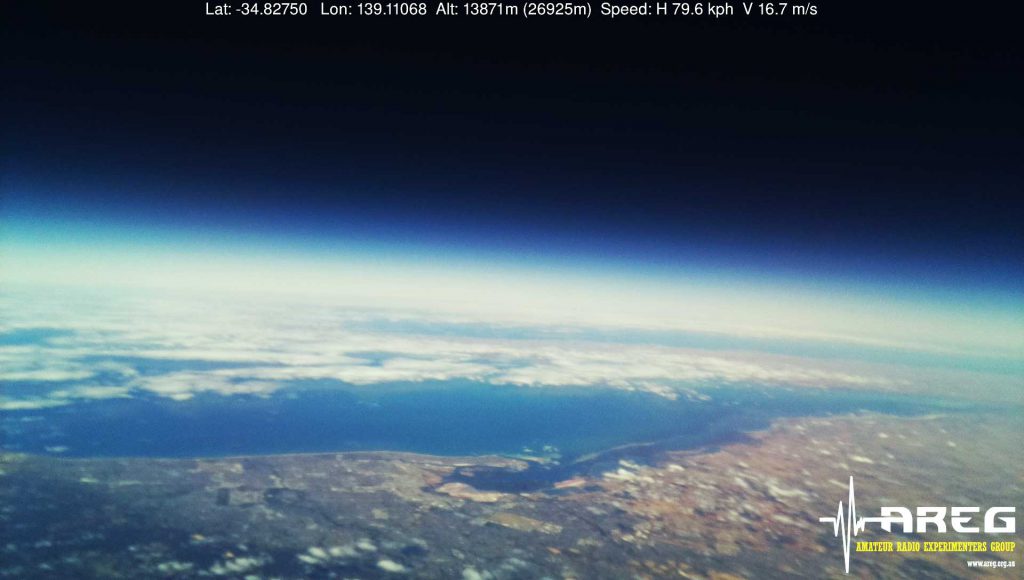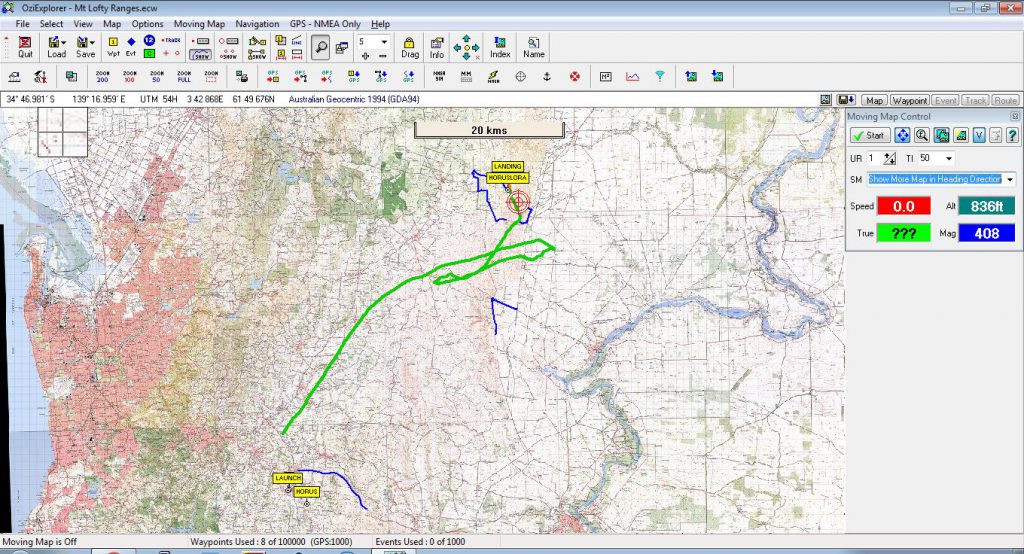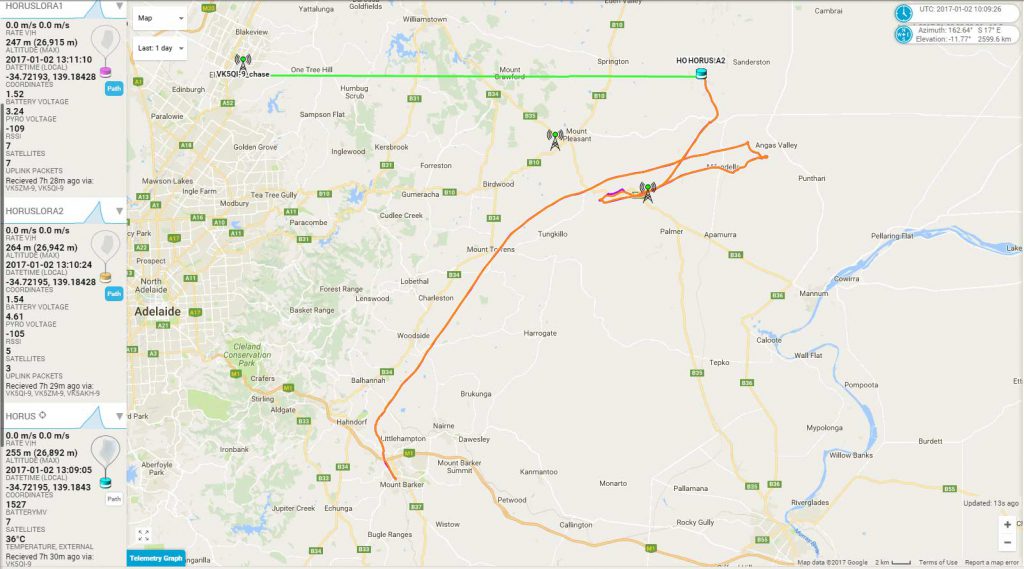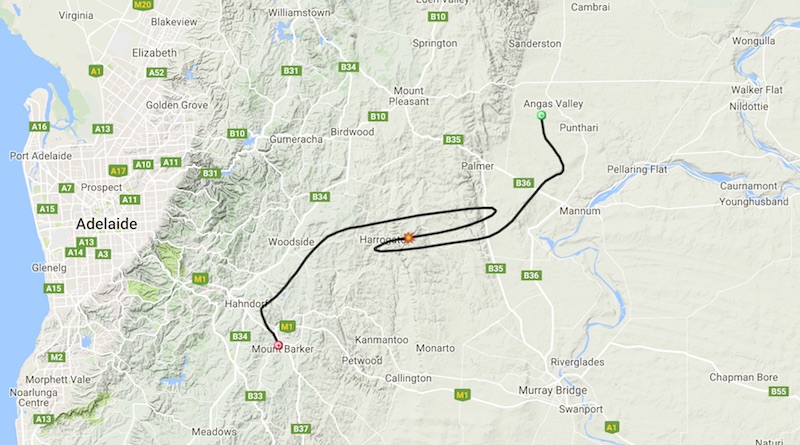Horus 41/42 Balloon Flights – Sunday 22nd Jan – Frequencies
The Amateur Radio Experimenters Group is pleased  to announce that it has been invited back to participate in the International Space University’s Southern Hemisphere Space Studies Program (SHSSP) for 2017.
to announce that it has been invited back to participate in the International Space University’s Southern Hemisphere Space Studies Program (SHSSP) for 2017.
This year, the club will be extremely busy with plans to simultaneously launch two balloons from two launch 
sites. This means double the number of payloads to track and double the fun for the launch and tracking teams as well!
Flight Times / Locations:
Horus 41 – McLaren Vale – 10:00am ACDT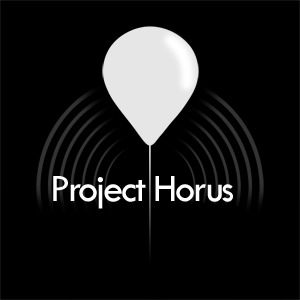
- RTTY Telemetry: 434.650MHz 100 bps
- Wenet Imagery Payload 441.2MHz 115Kbit/s
Horus 42 – Mt Barker – 10:00am ACDT
- RTTY Telemetry: 434.075MHz 100 bps
- Wenet Imagery Payload: 443.5MHz 115Kbit/s
Both balloons are intended to be launched simultaneously! Listen on the VK5RSB 70cm repeater for the launch coordination. Tracking details for RTTY payloads can be found here (click).
[wpgmza id=”12″]
Launch Site Map
Payload Information
The university project this year is using the Wenet payload designed by Mark VK5QI to accommodate 2 cameras taking alternate photographs, both facing downwards. One will be shooting in the visible light spectrum while the other will be photographing the IR spectrum. Additional telemetry is now being included also, with an Inertial Measurement Unit on board giving payload orientation data. The hope is to combine the data from both balloons into a stereoscopic representation of the terrain and vegetation below.
All of the images are being collected live and will be available via the Internet (watch this page for details closer to the day).
How to get involved?
Visitors are welcome at the launch sites on Sunday morning. AREG members are encouraged to dress in their club apparel as there will (hopefully) be lots of media around, at least at the McLaren Vale launch site at Serafino’s Winery.
You can get involved in tracking the flights from home. The more stations involved, the better! We will have our hands full with two balloons in the air so help from ground stations collecting telemetry and forwarding it to the Internet for us.
For the adventurous, you may also like to get involved in receiving the Wenet transmissions and receiving the pictures directly! All you need is a Linux based PC running Ubuntu 16.04 RX, an RTL-SDR Dongle, a preamplifier (because the RTL-SDR needs all the help it can get) and a suitable UHF 70cm antenna.
Details of the receive system are given on Mark VK5QI’s GitHub page: https://github.com/projecthorus/wenet
If you would like more information, contact the president, Matt VK5ZM@wia.org.au
More news as the launch gets closer and details are confirmed. We wont know with reasonable certainty that we are flying until ~48hrs before liftoff.
Next Meeting: 20th Jan – Radio Beginner Series: The art of QSLing
During 2017, the AREG is planning a set of presentations to be known as the “Radio Beginner Series”. The intention is that every 4 months, the evening will be dedicated to something simple, but which any beginner starting out may not have been exposed to before. Ideal for foundation licensees, but also equally applicable to old hands trying out a new aspect of the hobby that they haven’t engaged with before.
The Art of QSL Cards and Confirmations
This month, the topic of sending and receiving QSL cards will be introduced, including all of the ways that you can achieve confirmation of your contacts, particularly if you are chasing awards. The talk will cover things like:
- QSL card design – what to put on your cards
- Ways of sending physical cards
- Bureau
- Direct – IRCs and “Green Stamps”
- via QSL Managers
- How to get electronic confirmation
- ARRL’s Logbook of the World
- eQSL.cc
- ClubLog Log Matching & OQRS QSL Request Services
- How do you manage Multiple Logs on these services?
The doors will open at 7.45pm, with meeting starting at 8.00pm. After the main presentation, tea coffee and supper is available followed by a general meeting. Hope to see you there!
[wpgmza id=”5″]
Horus 40 Flight Report: January 2nd 2017
On Monday January 2nd 2017, the Amateur Radio Experimenters Group launched a test flight of some new telemetry equipment, and trialed the updated Wenet SSDV system being developed by the group. The aim was to validate some new software ready for a dual flight being planned for January 22nd for the Southern Hemisphere Space Studies Program (SHSSP) run by the University of South Australia.
Launch Preparations
The payloads being flown this flight included:
- RTTY Telemetry (434.650 MHz 8N1 ASCII 100baud) – The usual RTTY payload as has flown in the past.
- Flight Control payload (TDMA) – we use this for telecommand to terminate the flight at the right altitude
- Secondary Test Flight Control Payload (TDMA) – In-air test of new TDMA software updates.
- Wenet Imagery Payload – 441.200 MHz 115Kbit/s Wideband FSK
- GoPro HD Hero 3 Video Payload – 25fps 1080p video – to be collected after landing
Wenet had been upgraded this flight to send back 1920×1080 frames and include on each frame some telemetry information too!
Balloon Launch Crew
On the ground, we had a large contingent of members from the Project Horus team. Matt VK5ZM lead the assembly of the balloon payload train while Mark VK5QI tended to the payloads. Grant VK5GR, Josh VK5JO, Gary VK5FGRY and Andrew VK5XFG set about filling the balloon.
Liftoff went flawlessly, which meant the chase and tracking was next.
Flight Ground Tracking Network
As in Flight 39, Peter VK5KX and crew stationed themselves on top of a hill over looking Palmer in the Adelaide Hills. From there, he was able to receive much of the data from the Wenet transmitter carrying the SSDV data.
When the balloon reached 15km altitude and was almost directly overhead, he also reported that using a telescope he was able to get a visual lock on the balloon for a time!
Bob VK5FO and Ray VK5RR operated ground control No.2 from their home near Waikerie in the Riverland. Bob reported:
“We were really trying to run several experiments on our rx capability and do a bit of a shakedown before the Dual launch. Some things worked, some things failed – but we have a much better insight into what is needed.
First off the Good.
Wenet – both of our Wenet RX set ups worked great – well, WinSDR, Pre-Amp and Laptop with software. We again used a dual-band white stick antenna – so about 8db gain on 70cm. We were able to RX images from 1,800M up to 25,000M and then from 25,000 back down to just 900M! Abovr 25,000M we did see some data, but not reliable at all.
Our 2nd Antenna – we used for experimenting with was nothing more than a mobile dual band whip – and we may as well have not bothered from this distance – 4.5db gain does not cut it.
This is very similar to what we experienced the previous flight – but this flight was much closer to us – about 90km v’s the 120-130km of the last one and as a result we had rock-solid +10db WENET signals for most of the flight – except when it was very close to the ground and again once it flew out of the antenna pattern over 25,000M
Except during the extremes, we had almost 100% decode on all images – well over 100Meg of images in the images directory!
…and then the not so good…
We had a lot of trouble even hearing the RTTY telemetry – and it was not until it was about 6,000M that we even heard it! We used our usual set up – of the IC-7100 in the car with a dual-band mobile whip to RX – and this is what we have used in the past without issue – Not so much of an Issue – except that it provides useful information WRT the Az and El of the balloon from your location – which might be needed – especially to be able to track the Payload with a directional array.
I suspect that we were had the car parked behind the shed and it was causing us to sit in the shadow of the flight until it hit the 6,000M mark. This is something easily rectified on the next flight – move the car or put the antenna on the shed roof!
As usual, the RTTY should be able to be decoded by anyone within about 100km with a fairly simple antenna, further with a little bit of gain.
So, while not everything was perfect, we were very happy with the resultant WENET Images we received.”
Flight Data
The end result of all of the ground station work was that the Wenet SSDV image payload worked a treat, Here is a slideshow of the pictures captured:
In addition, a GoPro was flown on the flight. The payload container this time suffered from some stability issues and so the images are not fantastic quality, but we did get some excellent frames out of the video at the time of balloon separation due to the tumbling. A number of selfies were taken of the other payloads and the parachute just as decent began. Check out the video here:
Flight Statistics
The flight itself was almost a text book affair. The flight track can be seen in the following animation created by Grant VK5GR from the telemetry raw data.
The vital statistics are:
[table “” not found /]
The final flight tracks can be seen here:
Chase & Telemetry Teams
The chase tracking for this flight was carried out by three teams this flight. Matt VK5ZM formed a team with Grant VK5GR, Josh VK5JO and Andrew VK5XFG, Andy VK5AKH had a team with Will Anthony VK5AHV, Darin VK5IX and his son Cam, and Mark VK5QI had a team with David VK5DGR and Gary VK5FGRY.
The chase teams in particular were using this flight to also get ready for the big dual flight planned on January 22nd.
The team would like to thank all of the following stations for their contribution to the telemetry collection effort:
VK5AKK VK5DF VK5EU VK5FTAZ VK5KJP VK5KX VK5NEX VK5NG VK5QI-1 VK5QI-9 VK5RR VK5ZEA VK5ZM VK5ZRL
Recovering Horus 40
The team had always planned on terminating the flight early as trying to recover the payloads in the Adelaide Hills, particularly the fairly remote eastern side is never easy. There were a number of tense minutes when the trigger mechanism appeared not to work, causing the balloon to fly further east than planned. Our worst nightmares looked like they were then going to materialize with a landing targeting the mountain goat country on the back of the escarpment. Fortunately, the payloads landed in a relatively accessible location, not far from an access road. A short hike up a hill and everything was found intact laid out before us awaiting collection.
Conclusion
Everyone declared Horus 40 a success, despite the issues with the delayed flight termination. Some fantastic images were obtained of Adelaide from 26km altitude, encouraging the team to continue to fly the SSDV payloads and enhance the ground station tracking systems. (More on that to follow).
Regards, The Project Horus team
VK5RSB Repeater Extended Outages

Photo of downed powerlines courtesy ABC News
AREG’s VK5RSB Summertown repeaters have been off air since Tuesday evening’s violent storm which has taken out power lines that feed the site. The restoration work according to SAPN is still progressing. The latest estimate for restoration is now 1.00pm today (31st December)..
We apologies for the outage on these major Adelaide repeater services, and are looking to see what can be done to reinstate the battery backup at the site which has failed.
Horus 40 Launch imminent – Jan 2nd 2017
Weather conditions are now looking somewhat better for a launch on Monday the 2nd of January. Liftoff is planned for 10.00am ACDT.
Ground wind conditions at Mt Barker should be light, and the current prediction (with some tweaking of launch parameters), has us landing somewhere north-east of Palmer:
Launch Details
The team will be launching from the Mt Barker High School oval. Our NOTAM’d launch time is 10AM ACDT, so we will be on-site from about 8:30-9AM. It is expected that balloon filling will take a bit longer this time, as we really need to get the balloon fill spot-on to achieve the desired flight path. Given this is an AREG test launch, visitors from the Amateur Radio community are welcome!
Payloads
There will be 5 payload boxes on this flight! (The most in a while)
- RTTY Telemetry (434.650 MHz 8N1 ASCII 100baud) – The usual RTTY payload as has flown in the past.
- Flight Control payload (TDMA) – we use this for telecommand to terminate the flight at the right altitude
- Secondary Test Flight Control Payload (TDMA) – In-air test of new TDMA software updates.
- Wenet Imagery Payload – 441.200 MHz 115Kbit/s Wideband FSK
- GoPro HD Hero 3 Video Payload – 25fps 1080p video – to be collected after landing
As usual, you’ll be able to select the flight from a drop-down list in dl-fldigi to decode the RTTY.
Tracking will be available via habhub.org 
Wenet SSDV imagery will be available via ssdv.habhub.org/VK5QI
Wenet Payload
For those club members involved in the Wenet payload data collection. you *should* be able to decode it using the software stack from last flight, however some Raspberry Pi firmware updates have slightly adjusted what ‘115200 baud’ actually means (115387 -> 115177 baud). Receivers running the old software are going to see a fairly large symbol rate error, and may experience a performance hit because of that. While the old software should work, the best preparation would be to upgrade your software.
As an upgrade, this flight will be sending ‘Full HD’ 1080p images, which should make nice desktop backgrounds! Note that this flight will be sending maybe 2x the number of images as the previous flight, due to some threading improvements made to the software.
As always, the Wenet ground-station software is available on Github at: https://github.com/projecthorus/wenet with an install guide for Ubuntu Linux here. A RTLSDR and a 70cm preamplifier are required for reception.
Launch Site Map
For those who want to see the balloon filled and lift off, here is the venue:
[wpgmza id=”10″]
Next Balloon Flight in Planning Stages
The Project Horus team through the Amateur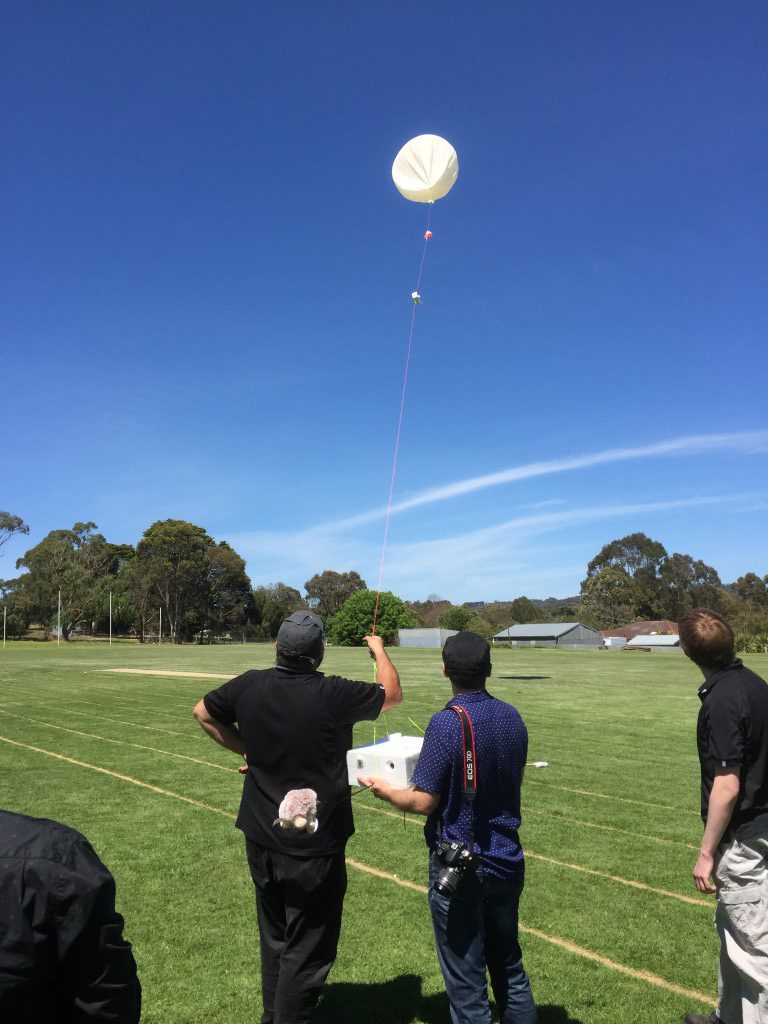 Radio Experimenter’s Group is planning another balloon flight!
Radio Experimenter’s Group is planning another balloon flight!
Well I’ve got NOTAM’s booked in for the 2nd, 4th, and 6th (Monday, Wednesday and Friday) 10AM, with the plan being to fly on Monday 2nd January. If the predictions are poor for the Monday (which is possible, given what’s coming towards SA weather wise over the next couple of days), then we may have to move to one of the other days, depending on personnel availability.
- Wenet SSDV payload (new box which I still need to build, new hardware), flying updated software. This will now have live GPS data overlaid on the image, as well as an AREG logo overlay. The images are now also full 1080p, so we’re effectively downlinking desktop backgrounds
- RTTY Telemetry (the usual, 434.650 MHz)
- Possibly a GoPro HD video camera We’ll evaluate that one closer to the date, and once I actually have a box made up for it.
Merry Christmas and HNY 2016
 The AREG executive and committee would like to wish all AREG members and Amateurs world wide a very Merry Christmas and Happy New Year.
The AREG executive and committee would like to wish all AREG members and Amateurs world wide a very Merry Christmas and Happy New Year.
Until next year stay safe and enjoy the Holiday DX Season.



